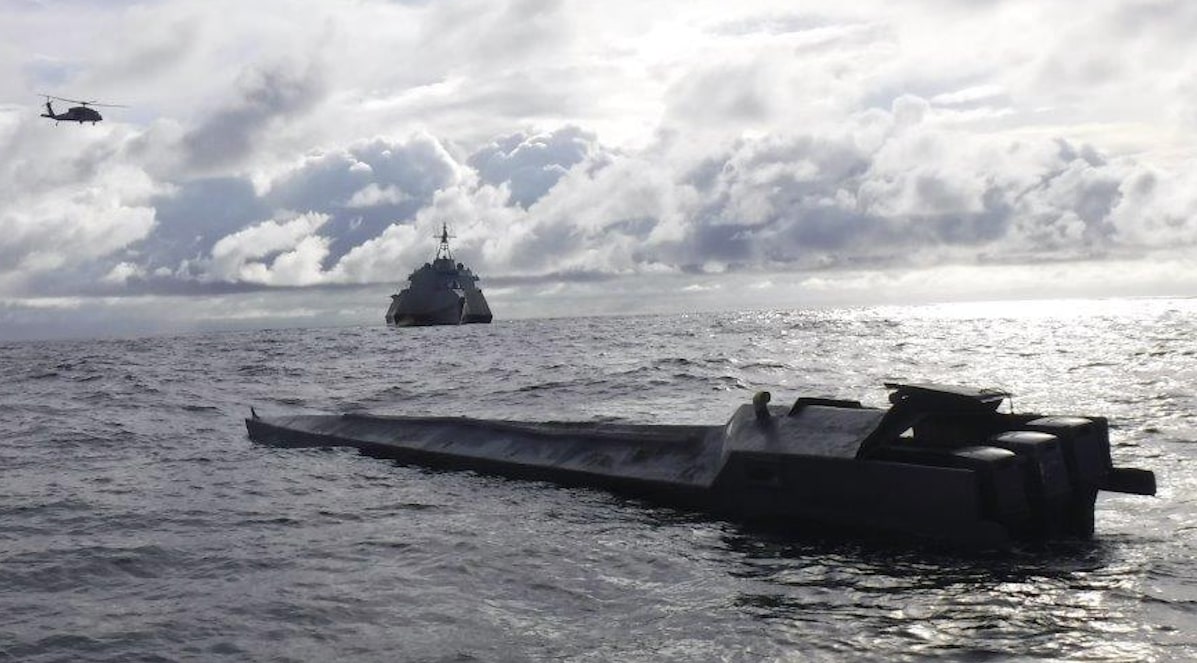An autonomous semi-submersible modeled on the “narco submarine” used for smuggling drugs into the United States is among a series of unconventional manned and unmanned systems the US Marine Corps (USMC) is testing to address its logistical challenges before China in the western Pacific.
The USMC is also looking at other systems to relieve its logistical burden. These include a Landing Ship Medium (LSM), a midway between a basic landing craft and the US Navy’s larger amphibious ships and unmanned aerial vehicles (UAV) to reach remote and inaccessible locations.
While logistical and doctrinal issues remain a problem, as has been touched on in earlier reports in EurAsian Times, the USMC is appearing to be independently pursuing fixes by the time the US Department of Defense (DoD) comes up with larger permanent solutions.
US’s Logistics Woes
Described as the “tyranny of distance” by the US military owing to the vast gaps between the various island bases in the western Pacific region that make supplying even a slightly extended conflict difficult, USMC units cannot rearm themselves rapidly enough.
China’s ‘home’ advantage in the region keeps its navy well supplied even as it destroys any US or allied attempts to do so.
Island-hopping USMC units from the Marine Littoral Regiments (MLR) armed with anti-ship systems like the Naval Strike Missile (NSM) are expected to operate from friendly Japanese or Philippine-controlled features in the South and East China Seas.
The small, mobile, hard-to-detect units can either harass or sink People’s Liberation Army Navy (PLAN) vessels by operating in the restricted Anti-Access/Area-Denial (A2/AD) bubble while also presenting additional targets for Beijing’s military.
The People’s Liberation Army’s (PLA) long-range missiles like the ‘carrier-killer’ DF-21D anti-ship ballistic missile (ASBM) are designed to tackle an enemy naval armada before it comes close to Chinese waters. It also has a host of land-attack cruise and ballistic missiles that can simultaneously strike bases in the first and second island chains.
Guided by its Force Design-2030 (a strategic overhaul aimed at transforming the Marine Corps into a more agile, technologically advanced force) and the US Navy’s Expeditionary Advanced Base of Operations (EABO) concepts, the USMC’s basing plans for the missile firing units face the same hurdles dogging the USN’s operations in the western Pacific: logistics.

Medium Landing Ship
In the 2025 budget proposal, the Marine Corps has requested funds to purchase its first Landing Ship Medium, a new design meant to be more advanced than a basic landing craft and the Navy’s much larger amphibious ships.
Engineered to release troops and material in areas without port facilities, they are “expected” to be more survivable, largely due to their improved ability to “hide among islands and other sea traffic,” according to a Congressional Research Service (CRS) report. The Naval Sea Systems Command (NAVSEA) said the basic requirements were finalized early in 2023.
USNI News said the LSM is required to have an 8,000 sq ft cargo area and be capable of carrying at least 75 Marines and 600 tons of equipment. “Specific configuration details will be determined during the detailed design phase, but generally, the ship will be less than 400 feet long, have a draft of less than 12 feet, an endurance speed of 14 knots, and roll on/roll off beaching capability,” reads the statement from NAVSEA.
The ship will also sport two 30-mm guns and positions for six .50-caliber guns around it, besides a helicopter pad and a crew of about 70 sailors for “light defense.” In 2021, the Navy awarded “study contracts” worth $7.5 million to five companies, including Fincantieri, Austal USA, then-VT Halter Marine, Bollinger, and TAI Engineers.
On March 19, the USMC reported testing the “Stern Landing Vessel,” a “modified oil-rig industry off-shore support vessel,” to “inform the development of the Medium Landing Ship.” The test was conducted by the Marine Corps Warfighting Laboratory, which aimed to “experiment with maneuver and sustainment options for Stand-In Forces.”
A picture showed the SLV dropping its ramp on the beach to load cargo at the Del Mar Boat Basin in Camp Pendleton, California. The effort was part of a program named Project Convergence Capstone.
‘Narco’ Sub-Inspired Semi-Submersible
In February this year, the USMC tested “a prototype logistics supply drone inspired by drug smuggling narco subs,” also under the aegis of Project Convergence Capstone that tested the SLV at the same Marine base.
The autonomous low-profile vessel is “a potential way” for the Marine Corps to “perform resupply in a wartime scenario when adversaries would seek to cut off sea lines of communication.”
“This upcoming Capstone 4 is going to be the first operational (event) in the context of an exercise where we’re going to use it,” Lt Gen Karsten Heckl told reporters at the WEST 2024 conference. The semi-submersible vessel is “very, very affordable, almost to the point of being attritable.”
Throughout 2023, the USMC performed “loading” and “offloading” of the prototype from a stern landing vessel and a Spearhead-class expeditionary fast transport ship in the James River in Virginia. The vessel was modeled after narco submarines used by drug runners, which Heckl noted that the Joint Interagency Task Force South had trouble tracking in the US Southern Command.
In a contested logistics environment, the Marine Corps would need assets that could stealthily perform resupply, and making a semi-submersible with minimal wake is an ideal option. “We just took a page out of the narco drug runners’ playbook,” Heckl said.
Heckl said the autonomous low-profile vessel can carry two Naval Strike Missiles and fulfills the Marine Corps’ need to focus on lethality in contested logistics. “It’s specifically form functioned to meet the cube and weight of two (Naval) Strike Missiles for our NMESIS systems,” he said, referring to the Navy-Marine Expeditionary Ship Interdiction System.
- The author can be reached at satamp@gmail.com
- Follow EurAsian Times on Google News




